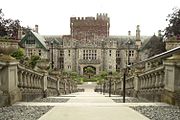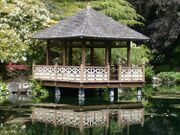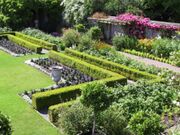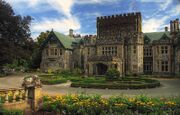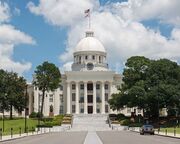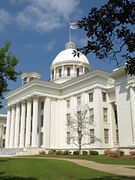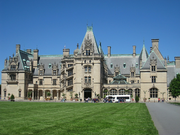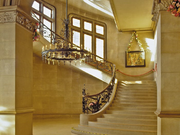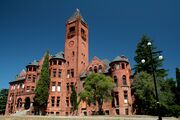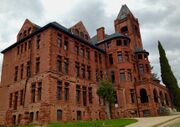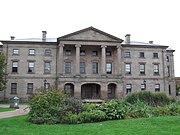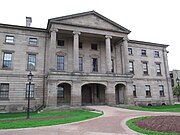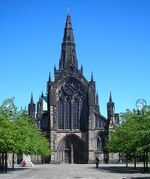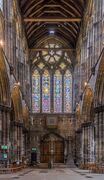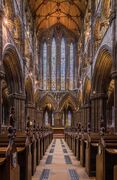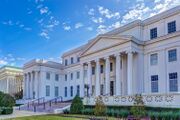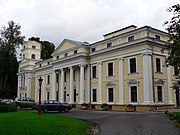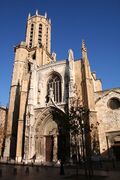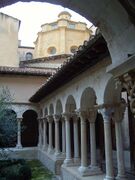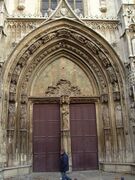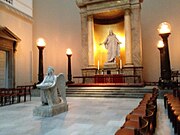List of Ebrarian National Landmarks
A National Landmark (Ebrarese: Puncto National de Referiment), or PNR, is a building, district, object, site, natural feature, or structure in Ebrary that is officially recognized by the Ministry of Environment and Tourism for its noteworthy historical, natural, scientific, or religious significance.
All Ebrarian national parks are considered to be a PNR, but not all areas designated as a PNR are national parks. The designation of PNR also encompasses areas with varying levels of protection, such as cultural sites or even privately-owned property of national significance. Privately-owned PNRs are protected to a certain degree, and major renovations, restorations, or changes may be blocked by the Ministry of Environment and Tourism.
Aberna
Parco National Foreste Ancerde
Parco National Foreste Ancerde (Anglish: Ancerde Forest National Park) is the second largest national park in Ebrary, about 2/3rds of which lies in Aberna and 1/3rd in the province of Opa. The park is made up of a large portion of the Ancerde Forest, which is some of Ebrary's last remaining temperate primeval forest. The forest itself is an ANESCO World Heritage Site. The national park is home to many bison and hunting is banned in the park. The Ancerde Forest has been protected in some form by the Ebrarian government since a 17th century decree by the king of Ebrary declaring the forest to be a royal hunting preserve. Some damage came to the forest during the Ebrarian Civil War, with Loyalist Militias occupying the area and hunting the local wildlife.
Adansema
Parco National Planas Benedicte
Parco National Planas Benedicte (Anglish: Blessed Plains National Park) is the largest national park and nature preserve in Ebraria, located in northern Adansema. The park comprises many square kilometers of temperate grasslands, and is home to some of the largest white-tailed deer herds in Argis. The park also contains a famous rare white deer herd, which has grown to almost 800 members in recent years.
Ceres
Castello Providence
Originally a folly commissioned by Ceres mayor Marco Sartor in 1904, Castello Providence is now the official residence of the Sovereign Protector. Castello Providence sits on a large estate of gardens and forest in the Ebrarian capital. The structure was built in the Gothic Revival style. After the Ebrarian Revolution, the government of Ebrary purchased the castle for official use and Sovereign Protector Daniel Lucas made it his full-time residence in 1987. It is sometimes referred to by its previous name, Castello Ceres.
Gardens at Castello Providence
Three gardens are part of the grounds of Castello Providence: the Rose Garden, the Occidental Garden, and the Oriental Garden. The gardens are maintained and have served as staging-grounds for diplomatic talks, press conferences, and social gatherings hosted by the Sovereign Protector. A team of full-time groundskeepers and gardeners are employed by the Ebrarian government to maintain the gardens and the rest of the grounds.
Palatio de Estalta
The Palatio de Estalta is the meeting place of the Ebrarian Parliament, located on Estalta Hill in Ceres. The building was constructed from 1867 to 1869 in the Laimiaic Revival style to house the Parliament of the Kingdom of Ebrary after the previous building burned down. Successive legislatures in Ebrary have met in the building.
This building is where many noteworthy events in Ebrarian history have occurred, including the 1932 Proclamation of the Republic and the adoption of the current Ebrarian Constitution in 1983.
Palatio Presidential
Constructed between 1935 to 1942 in the Châteauesque style, the Palatio Presidential is the official residence of the president of Ebrary. The building was never used by the presidents of the Republic of Ebrary, because of a coup in 1943 which reinstalled the monarchy. However, the royal family of Ebrary appropriated the home and significantly renovated it for use as a royal residence. During this time, it was referred to as the Palatio Nove Royal (New Royal Palace). After the Ebrarian Revolution, all royal buildings were confiscated by the new government, and the building was then selected by a Parliamentary committee and approved by vote of Parliament as the official residence of the president of Ebrary.
The Palatio Presidential's grand size has enabled it to also house the offices of the president and deputy president, their chief counselors and advisors, the president's press secretary and state press corps, and all support staff.
Castello Corporation
The Castello Corporation (Anglish: Guild Castle) is the home of the Supreme Court of Ebrary. The building was built in the Aromanesque revival style in 1885. The building served as an administrative building of the province of Laverna until the 1950s and then as a storage and office building for the government of the Kingdom of Ebrary. The building became the home of the Supreme Court in 1991 and was renovated in 2005, but the Supreme Court moved once again to Casa National in 2010 and the Castello Corporation became an annex of the Ebrarian Museum.
Casa National
Casa National (National House) houses the Ebrarian Supreme Court. The building was erected in 1850 in the Aroman/Laimiaic Revival style to house the Royal Chamber Court. During the Republican Era (1932-1943), the building housed the offices of the President of Ebrary, but the 1943 restoration of the monarchy saw the building become the home of the High Royal Court. After the 1980-82 Ebrarian Revolution, the building was selected by Parliament to house the State Synod, but the Synod refused to meet there. After renovations were completed in 2009, the Supreme Court moved to the building in 2010.
In front of Casa National is a small monument to Ebrary's fallen soldiers in the Ebraro-Aurivizht War and the Gallasian War.
Cathedral de Ceres
The Cathedral de Ceres is the seat of the Bishop of Ceres, head of the Church of Ebrary. It was built in the Gothic style in the 12th century. Iconoclasts destroyed much of the iconography after the Ebrarian Reformation. The cathedral houses the relics of St. Marcus Ebraius, and it was named the Cathedral de St. Ebraius until 1567 when it was renamed to its current name.
Church of the Pentecost
The Church of the Pentecost, or officially the Cathedral of the Pentecost, in Ceres is an Aroman Christian cathedral, the seat of the Archbishop of Laverna, and the headquarters of the Orthodox Aroman Church in Ebrary. The building was originally constructed in the early 1800s, built with funds provided by the monarch of Ebrary to the Church of Ebrary. The building is Gothic in style. Ownership of the building was transferred in 1939 to the new Ebrarian Aroman Church. During the 1940s, the building was renovated and artwork conflicting with the iconoclastic stance of the Aroman church was removed.
Ebrarian Museum
The Ebrarian Museum is a public museum which was built during the Republic of Ebrary from 1936-39 in the Neoclassical style to house the then-named Museum of the Ebrarian Republic. After the Restoration of the Opa Dynasty, the museum was renamed to the Royal Ebrarian Museum. It was again renamed simply to the "Ebrarian Museum" after the monarchy was overthrown in the early 1980s. An east wing was completed in 1965 and a west one in 2010. Entrance to the museum is free to Ebrarian citizens and and permanent or temporary residents, with a nominal fee charged to foreign tourists.
While the collections of the museum include artifacts from all of Ebrarian history, the museum is noted for its sizeable antiquities collection and the confiscated crown jewels and art collections of the former Ebrarian monarchy. The museum is jointly operated by the Ministry of Culture and Christian Affairs and the Ministry of Education, with funding directly allocated to the museum by the Ebrarian Parliament.
Egschwil
Egschwil Palace
Egschwil Palace is a neoclassical manor house built in the 18th century, and the home of the Egschwil National Art Museum. It was built on the site of the 14th century palace of the Vorstish kings, which was destroyed completely in a fire in 1753. The current structure was constructed in the 1770s to house the royally appointed Governor of Vorstland.
Laverna
Caverna Petra
Caverna Petra is a prehistoric dolmen located in northern Laverna province. It is widely considered to be Ebrary's most iconic landmark dating from prehistoric times. The megalith dates from 3000 - 2500 BCE and was constructed from blocks of granite. The site was excavated in the early 20th century and found to contain beads, pottery, and human remains, and it is presumed the site was a tomb or burial place of some sort.
Urtedo Cathedral
Urtedo Cathedral, located in the city of Urtedo is the seat of the Archbishop of Urtedo, and the headquarters of the Ebrarian Orthodox Church. The cathedral is built on the site of a 6th-century Aroman-style church. Renovated and rebuilt from the 13th until the early 19th century, it includes Aroman columns and parts of the original 6th-century church, as well as Gothic, Neo-Gothic, and Aromanesque styles. Before the Ebrarian Reformation, the church housed a monastic community, but their organization was dissolved by the Church of Ebrary during the reign of King Gustav II. From there, the cathedral served various functions, but a mob of iconoclasts did great damage to the cathedral in 1585. Restoration work was performed on the cathedral in the centuries afterwards, including the restoration of a great many sculptures and icons. The cathedral was transferred to the Orthodox Church in 1940 after their separation from the Church of Ebrary.
Church of St. John the Baptist, Urtedo
The Church of St. John the Baptist in Urtedo is the first church, with special place of honor, of the Ebrarian Parishist Union. It was completed in 1845 in the Neoclassical style of architecture. It is noted for famous statues of Jesus and his apostles inside the building, and Moses on the exterior.
